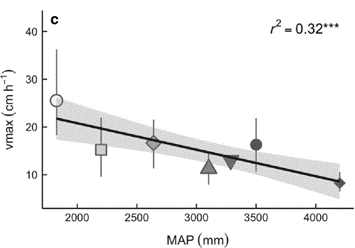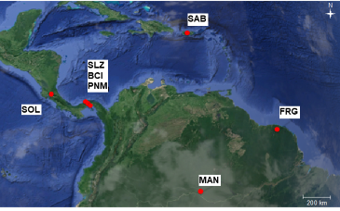The Science
Climate – specifically annual precipitation – modulates the speed with which water is transported through tropical trees.
The Impact
This study demonstrates that local climate plays an important role in the sap flux response of humid tropical forests to evaporative demand. Moreover, we highlight that trees growing in wetter regions in the tropics may be subjected to a reduced sap flux velocity with the high evaporative demand predicted by most climate models.
Summary
Transpiration in humid tropical forests modulates the global water cycle and is a key driver of climate regulation. Yet, our understanding of how tropical trees regulate sap flux in response to climate variability remain elusive. With a progressively warming climate, atmospheric evaporative demand (i.e., vapor pressure deficit, VPD) will be increasingly important for plant functioning, becoming the major control of plant water use in the 21st century. Using measurements in 34 tree species at seven sites across a precipitation gradient in the neotropics, we determined how the maximum sap flux velocity (vmax) and the VPD threshold at which vmax is reached (VPDmax) vary with precipitation regime (mean annual precipitation, MAP; seasonal drought intensity, PDRY) and two functional traits related to foliar and wood economics spectra (leaf mass per area, LMA; wood specific gravity, WSG). We show that, even though vmax is highly variable within sites, it follows a negative trend in response to increasing MAP and PDRY across sites. LMA and WSG exerted little effect on vmax and VPDmax, suggesting that these widely-used functional traits provide limited explanatory power of dynamic plant responses to environmental variation within hyper-diverse forests. This study demonstrates that long-term precipitation plays an important role in the sap flux response of humid tropical forests to VPD. Our findings suggest that under higher evaporative demand, trees growing in wetter environments in humid tropical regions may be subjected to reduced water exchange with the atmosphere relative to trees growing in drier climates.


Contacts (BER PM): Daniel Stover, SC-23.1, Daniel.Stover@science.doe.gov (301-903-0289)
PI Contact: Grossiord Charlotte(1) & Brad Christoffersen(2), (1) Swiss Federal Institute for Forest, Snow and Landscape Research WSL, Birmensdorf 8903, Switzerland; (2) Department of Biology and School of Earth, Environmental, and Marine Sciences, University of Texas Rio Grande Valley, Edinburg, TX, USA; charlotte.grossiord@wsl.ch; bradley.christoffersen@utrgv.edu
Funding
This project was supported in part by the Next Generation Ecosystem Experiments Tropics, funded by the US Department of Energy, Office of Science, Office of Biological and Environmental Research, Terrestrial Ecosystem Sciences Program, under Award Number DE-SC-0011806. CG was supported by the Swiss National Science Foundation SNF (5231.00639.001.01). BC was supported in part by the Laboratory Directed Research and Development Program Project 8872 of Oak Ridge National Laboratory, managed by UT-Battelle, LLC, for the U. S. Department of Energy. This work has benefited from an “Investissements d’Avenir” grant managed by Agence Nationale de la Recherche (CEBA, ref. ANR-10-LABX-25-01). Data recorded in French Guiana (FRG) were collected at the Guyaflux sites which belong to the SOERE F-ORE-T and is supported annually by Ecofor, Allenvi and the French national research infrastructure, ANAEE-F.
Publications
Grossiord, B. Christoffersen et al., “Precipitation mediates sap flux sensitivity to evaporative demand in the neotropics.” Oecologia (2019), doi: 10.1007/s00442-019-04513-x
Related Links
https://link.springer.com/article/10.1007/s00442-019-04513-x